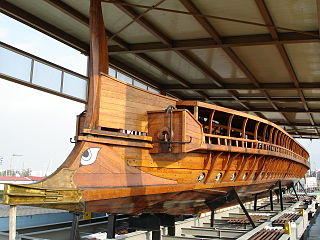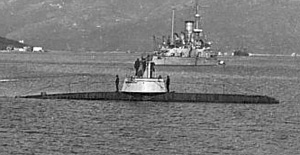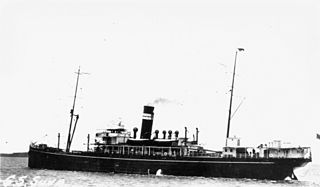
The Captain class was the designation given to 78 frigates of the Royal Navy, constructed in the United States, launched in 1942–1943 and delivered to the United Kingdom under the provisions of the Lend-Lease agreement. They were drawn from two classes of the American destroyer escort classification: 32 of the GMT (Evarts) Type and 46 of the TE (Buckley) Type. Upon reaching the UK the ships were substantially modified by the Royal Navy, making them distinct from the US Navy destroyer escort ships.

German submarine UA was one of fourteen foreign U-boats in the German Kriegsmarine during the Second World War.

A naval ram is a weapon fitted to varied types of ships, dating back to antiquity. The weapon comprised an underwater prolongation of the bow of the ship to form an armoured beak, usually between 2 and 4 meters (6–12 ft) in length. This would be driven into the hull of an enemy ship to puncture, sink or disable it.

The Clan Line was a passenger and cargo shipping company that operated in one incarnation or another from the late nineteenth century and into the twentieth century.

SM UB-10 was a German Type UB I submarine or U-boat in the German Imperial Navy during World War I.
SM UB-12 was a German Type UB I submarine or U-boat in the German Imperial Navy during World War I. The submarine disappeared in August 1918.

SM UB-16 was a German Type UB I submarine or U-boat in the German Imperial Navy during World War I. The submarine was sunk by a British submarine in May 1918.

SM UB-6 was a German Type UB I submarine or U-boat in the German Imperial Navy during World War I. The submarine was interned after running aground in neutral Dutch waters, and was scuttled by her crew at Hellevoetsluis.
His Majesty's or HM Armed Smack Inverlyon was a fishing smack that was converted to a Q-ship during the First World War. Q-ships served as decoys to lure German submarines near enough so that concealed weapons could be brought to bear and sink the submarines. On 15 August 1915, Inverlyon succeeded in luring German submarine UB-4 within range and sinking her with nine shots from her gun. The Royal Navy Gunner in command of the vessel, Ernest Martin Jehan, received the Distinguished Service Cross and members of Inverlyon's crew shared the bounty offered for German submarines. After Inverlyon's Q-ship career ended, she returned to fishing, but was sunk by U-55 on 1 February 1917.

SM U-52 was one of 329 submarines serving in the Imperial German Navy in World War I. U-52 was engaged in the naval warfare and took part in the First Battle of the Atlantic.

An armed boarding steamer was a merchantman that the British Royal Navy converted to a warship during the First World War. AB steamers or vessels had the role of enforcing wartime blockades by intercepting and boarding foreign vessels. The boarding party would inspect the foreign ship to determine whether to detain the ship and send it into port or permit it to go on its way.
HMS Goodall (K479) was a British Captain-class frigate of the Royal Navy in commission during World War II. Originally constructed as the United States Navy Evarts-class destroyer escort USS Reybold (DE-275), she served in the Royal Navy from 1943 until her sinking in 1945.

HMS Dianella was a Flower-class corvette of the Royal Navy. She served during the Second World War.










